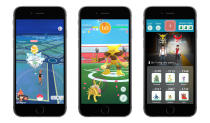'Pokémon Go' to get raid battles and simplified gyms
The new gym system is rolling out today, while raid battles are "coming soon."
A year after Pokémon Go captivated the world with its location-based catch-athon, Niantic is making some changes. The biggest is raid battles, a concept that was teased in the very first trailer for the game. They'll launch "in the coming weeks" and take place at existing gyms, allowing groups of players to take on rare and powerful Pokémon together. At first, you'll see an egg and a countdown timer, as well as one to four boss icons which indicate the creature's difficulty. When the meter drops to zero, the Pokémon will appear and you'll have a limited time to catch it.
Raid battles can be performed with public and private groups of up to 20 people. A simple lobby lists the players and Pokémon that will be joining the fray, giving you ample time to prepare while everyone else shows up and sorts out their party. Unsurprisingly, raid bosses have huge health bars and you'll need to tap furiously to inflict meaningful damage. It's a race against the clock — if the timer runs out, your chance to catch the Pokémon is gone. Until that happens, however, there's always a chance to push through and succeed. Even if your party is defeated, for instance, you can hop out, heal up and dive straight back in to help the rest of the group.
If you successfully defeat the boss Pokémon, you'll be rewarded with special bonus items including rare candies, golden razz berries and two types of technical machines, fast and charged. The game will also deal out some Premiere Balls, the number of which will vary depending on the team that controls the gym, the damage you contributed and the total damage from your team. You'll then have the chance to capture the Pokémon, just like a regular encounter, using berries and Premiere Balls exclusively. In short, if you do better in the battle section, you'll receive more balls and have a better chance of catching the Pokémon.

The feature is designed, however, so that everyone can contribute and have a reasonable chance of catching a powerful monster. Seasoned players will, of course, want to team up with equally talented trainers, which is where the private groups come in. If you set one up, the app will give you a shareable code (three Bulbasaur icons, for instance) so that other people can easily find and join your group. In the future, Niantic will also offer exclusive, invitation-only raids for the best players in the world. These will take place at specific gyms and provide a chance to catch the rarest and most powerful Pokémon in the game, including legendaries.
There's one small catch to the new feature: Raid passes. To join a cooperative battle, you'll need to supply one of these single-use passes upfront. You can grab one every day by visiting a gym, otherwise you'll need to buy them through the in-app store. Restricting participation makes sense, as it will help each raid feels special. If you want to be cynical, however, it's easy to see this as a money-making venture that encourages in-app purchases whenever a tough-to-catch Articuno shows up.
Before the raid battle update, Niantic is giving its gym system a complete overhaul. The developer admits they were needlessly complicated before and overwhelmed casual players. The replacement ditches the gym level and prestige systems entirely, and changes how players challenge the Pokémon left by other trainers. Now, every gym will have six available slots, and all of them must be inhabited by a different kind of Pokémon — no duplicates allowed. When you challenge a gym, you'll also take on the Pokémon who has been there the longest first, rather than the weakest.

Creatures left at the gym will have a motivation meter which falls alongside their CP, or strength, over time and as they participate in battles. Stronger Pokémon will also lose motivation faster than weaker ones. Trainers can restore motivation with berries, but the idea is that higher-level Pokémon will be booted out of gyms more quickly than before.
"We're really hoping that we can broaden the scope to encompass both levels of play," Edward Wu, director of software engineering at Niantic said. "That's part of why the motivation system exists. If you have a fully fed, and highly motivated Pokémon who the player is constantly giving berries to, that will still provide a top-tier challenge for the folks who expect a top-tier challenge. But in addition, as they weaken and get demotivated, that will give more casual players or, trainers who might not have fully levelled up yet, the chance to actually battle and win at those gyms."
Like the original games and anime, gyms will soon have badges too. As you battle Pokémon and participate in other activities, they'll level up through bronze, silver and gold. Higher-ranked badges will give you items, experience points and other bonuses every time you revisit the gym.
If you're disinterested in battling, fear not: Niantic has you covered too. Every gym will now also serve as a Pokéstop, allowing you to collect items and rank up badges like everyone else. If you give your Pokémon treats in the gym, you'll also receive some extra Stardust.
With a year under its belt, Niantic is focusing on features that encourage real-world socialising and collaboration. At some point, that will include Pokémon trading too. "We're absolutely interested in it," Wu said. "But as we've alluded to before, there are some really tough challenges associated with it. Since we have this single coherent world, where everybody is on the same instance, that's really quite unique in MMO games. So being able to make sure that trading mechanic is balanced and is fair, and does justice to our players when we have these particular challenges, is something we have been working on and will continue to work on."











